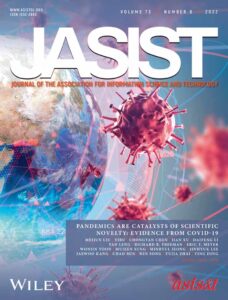JASIST Editorial Note: 1 July 2022
JASIST Editorial Note: July 1 2022
Steve Sawyer
In this editorial update, we celebrate our expert reviewers, some by name. We also highlight the role of peer review in JASIST’s editorial review process. You can read more on this on JASIST’s web presence.
Academic journals serve in large part as certification systems, with peer review occupying the core. Most scholars find academic papers online instead of in print journals, reducing the role of journals as curated collections, and challenging their role as locations of sustained discourse. These changes in the functions of academic journals also come at a time of increased attention to journal ranking, another topic that deserves commentary within a future editorial note.
—In this editorial update, we celebrate our expert reviewers. —
This evolution of academic journals has transformed peer review into an even more important element of academic publishing, particularly due to the increased focus on certification. And yet, peer review asks that expert reviewers voluntarily share their valuable insights with little recognition. Furthermore, expert reviewers are already one of the scarcest resources in the peer review process.
To this point, in 2020, about 600 people reviewed a manuscript for JASIST! And, in 2021, we needed more than 800 people to provide reviews (as more manuscripts were submitted to JASIST in 2021 than in 2020). Across two years, about 1000 of our colleagues took several hours out of their already-busy lives to donate time and insights to JASIST’s authors. Some of these reviewers provided multiple reviews of the same manuscript. We owe these colleagues a great deal of thanks. Reviewers: please feel free to update your CV and annual reviews to reflect that you have completed a review for JASIST!; we are always happy to confirm this for others should you need it!
Listed below are the ‘top reviewers’ from 2021, followed by those from 2020. This acknowledgment of our colleagues who have generously reviewed manuscripts reflects a first attempt to say “thank you.” To achieve this recognition these reviewers needed to complete at least four reviews and receive high ratings for their review work. This exceptional work noted, every review matters and we honor and value everyone who has contributed their expertise.
We will continue to thank reviewers and find ways to be more inclusive of all reviewers’ participation and hard work. For now, listed below are the 54 top reviewers from 2021 and 2020, five of whom have impressively made both lists. Our top reviewers hail from 15 different countries and reflect the impressive diversity of JASIST and contemporary information science.
Again, many heartfelt thanks to all of JASIST’s reviewers!
JASIST’s top reviewers for 2021, in alphabetical order by last name:
Christine Borgman, University of California Los Angeles, US
Ángel Borrego, University of Barcelona, ES
Yi Bu, Peking University, CN
Hiram Calvo, National Polytechnic Institute, MX
Andrew Cox, University of Sheffield, UK
Ina Fourie, University of Pretoria, SA
Yuanxi Fu, University of Illinois Urbana-Champaign, US
Anne J. Gilliland, University of California Los Angeles, US
Lisa Given, Swinburne University of Technology, AUS
Tim Gorichanaz, Drexel University, US
Lala Hajibayova, Kent State University, US
Daqing He, University of Pittsburgh, US
Jannica Heinström, Oslo Metropolitan University, NO
Chang Liu, Peking University, CN
Jiqun Liu, University of Oklahoma, US
Jinxuan Ma, Emporia State University, US
Jiaxin Mao, Tsinghua University, CN
Lynne McKechnie, University of Western Ontario, CA
Pam McKenzie, University of Western Ontario, CA
Aytug Onan, Izmir Katip Çelebi University, TR
Sarah Polkinghorne, University of Alberta, CA
Beth St. Jean, University of Maryland, US
Mike Thelwall, University of Wolverhampton, UK
Andrea Thomer, University of Michigan, US
Kirsty Williamson, Monash University, AUS
Adam Worrall, University of Alberta, CA
Dan Wu, Wuhan University, CN
Chengzhi Zhang, Nanjing University of Science and Technology, CN
JASIST’s top reviewers for 2020, in alphabetical order by last name:
Denise Agosto, Drexel University, US
Marcia Bates, University of California Los Angeles, US
Kevin Boyack, SciTech Strategies, Inc., US
Jenny Bronstein, Bar-Ilan University, IL
Yi Bu, Peking University, CN
John Budd, University of Missouri, US
Andrew Cox, University of Sheffield, UK
Zhichao Fang, Leiden University, NL
Tim Gorichanaz, Drexel University, US
Jenna Hartel, University of Toronto, CA
Hamid R. Jamali, Charles Sturt University, AUS
Kyungwon Koh, University of Illinois Urbana-Champaign, US
Krystyna Matusiak, University of Denver, US
Lynn McKechnie, University of Western Ontario, CA
Ola Pilerot, University of Borås, SE
Reijo Savolainen, Tampere University, FL
Joachim Schöpfel, University of Lille, FR
Mike Thelwall, University of Wolverhampton, UK
Ted Underwood, University of Illinois, Urbana-Champaign, US
Erjia Yan, Drexel University, US
Xiaojun Yuan, SUNY Albany, US
 Second, as part of celebrating our reviewers, the rest of this editorial note focuses on locating their work in JASIST’s manuscript review process. Recognizing both the importance and scarcity of reviewers, each manuscript is reviewed three times before we invite reviewers. The first review is done by the Managing Editor (ME), and two criteria are considered: First, does the manuscript’s topic and contribution align with the Journal’s editorial scope and focus? Second, does the manuscript’s formatting and structure meet the requirements laid out in the Journal’s author guidance?
Second, as part of celebrating our reviewers, the rest of this editorial note focuses on locating their work in JASIST’s manuscript review process. Recognizing both the importance and scarcity of reviewers, each manuscript is reviewed three times before we invite reviewers. The first review is done by the Managing Editor (ME), and two criteria are considered: First, does the manuscript’s topic and contribution align with the Journal’s editorial scope and focus? Second, does the manuscript’s formatting and structure meet the requirements laid out in the Journal’s author guidance?
Manuscripts that meet these criteria are then reviewed by the Editor-in-Chief (EIC). This review focuses on assessing the clarity of the contribution and further assessing the manuscript’s fit to the Journal’s scope and focus. Manuscripts that move through these two stages are then reviewed by a member of the Editorial Board. Based on their more expert consideration, the manuscript is either returned to the EIC (to be returned without further review) or it enters peer review and two or more reviewers are asked to further evaluate the manuscript.
About 40% of the manuscripts submitted to the Journal are returned during the first two steps. Another 10% are returned after consideration by one or more members of the Editorial Board. There are two reasons that we see so many ‘desk rejects’ and returns after editorial consideration: the first is that many submissions are not topically aligned with the Journal’s focus and scope. We owe it to these authors to return their work as swiftly as possible, typically in less than two weeks. The second reason for desk-rejections is to save our volunteer reviewers from having to work on manuscripts that have a lower likelihood of success in a blinded review process at JASIST. We recognize that editorial decisions are judgment calls; for this reason, in the decision letters we send to authors, we outline how you can seek more clarity regarding the decision.
Looking at data from our review efforts, we know it takes multiple invitations to secure a set of reviewers. We also know that one of the effects of the Pandemic is an increase in the number of requests needed to secure reviewers; members of the Editorial Board lament that reviewer selection has become an increasingly large part of their workload. As an aside, quality papers often seem like the second scarcest resource. The least we can do is ensure that the manuscripts we offer to reviewers will be interesting and of a reasonable standard.
Once a manuscript enters peer review, it takes about 80 days to return a first decision to the authors. The review cycle has four possible outcomes: “accept,” “minor revision recommended,” “major revision recommended,” or “reject.” In the revision process, most reviewers move forward with the manuscript, which is impressive! In moving forward, we limit the number of major revisions to two rounds, though it is worth noting that this is very rare, as time and effort are costly for both authors and reviewers. Luckily, very few manuscripts face this issue. Indeed, a large percentage of manuscripts that enter the revision cycle move to publication.
This summary of JASIST’s editorial process indicates that our reviewers are central to our certification of manuscripts. Moreover, the editorial process is designed to support both authors and reviewers, drawing on the expertise of the Editorial Board’s membership.
Thank you for reading this note, and please consider submitting your work to JASIST!
Steve Sawyer
Editor-in-Chief, JASIST
Professor, Syracuse University’s iSchool
Cite this article in APA as: Sawyer, S. (2022, July 1). JASIST editorial note: July 1 2022. Information Matters, Vol. 2, Issue 7. https://informationmatters.org/2022/07/jasist-editorial-note-1-july-2022/





